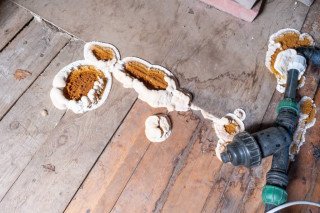Professional Mold Remediation Services
Don't Let Toxic Mold Put Your Family's Health at Risk
Stop mold damage before it spreads. Call now for a free, no-obligation estimate from a local remediation expert.
Free Estimate · Zero Obligation · Available 24/7
[Solved] Red Mold in Homes: What It Is & Is It Dangerous?
Red mold? Yep — it’s a thing. But it’s not just one type of mold.
“Red mold” is a nickname for mold species that appear red — usually during early stages or when growing on certain surfaces like drywall or food.
If you've spotted reddish mold in your home, this guide breaks down exactly what you’re dealing with, whether it’s harmful, and what to do about it.
🔬 What Is Red Mold, Really?
There’s no single species of mold called “red mold.” Instead, it refers to mold that looks red at certain points in its life cycle or when growing on specific materials.
Molds that can appear red include:
- Aspergillus – sometimes reddish on drywall or insulation
- Neurospora – red-orange mold often found on bread
- Rhodotorula – reddish yeast common in moist bathrooms and on food
- Fusarium – reddish mold found in soil and on houseplants
“Mold can be many colors, including white, orange, green, or black. It can appear fuzzy or slimy and often grows in moist places.”
— CDC Mold FAQ

⚠️ Is Red Mold Dangerous?
Usually? No. But that doesn’t mean it’s harmless.
Red mold on its own isn’t usually toxic, but it can cause health issues, especially in sensitive individuals:
- Sneezing and coughing
- Itchy eyes or rashes
- Worsened asthma
- Headaches or fatigue
Worse yet, red mold is often found alongside other molds, including toxic black mold (Stachybotrys chartarum).
“People with asthma, allergies, or immune conditions are more likely to react to mold exposure.”
— EPA
Bottom line: Red mold = excess moisture. That’s a red flag.
🧱 Where Does Red Mold Grow?
Red mold isn’t picky — it shows up wherever there’s moisture and something to feed on:
- Damp drywall, insulation, or ceiling tiles
- Around leaky sinks, pipes, or behind toilets
- In showers, on curtains, or window sills
- On spoiled bread, cheese, or fruit
- Even in HVAC systems or humid basements
If it's red, fuzzy, and in a damp space — it's likely mold, and it's time to act.
🔍 Red Mold vs. Pink Mold
People often mix these up:
- Pink mold is usually Serratia marcescens, a bacteria, not a mold. It’s found in bathroom grout or soap scum.
- Red mold is actual mold (a fungus), often found on building materials or food.
👉 Learn more about pink mold →
🧽 How To Clean Red Mold (Without Spreading It)
✅ Safe to DIY If:
- The area is small (< 10 sq. ft.)
- It’s on non-porous surfaces like tile or plastic
Steps:
- Wear PPE (N95 mask, gloves, goggles)
- Spray with vinegar or a mold-specific cleaner
- Scrub and discard the cloth afterward
- Dry the area completely
- Run a fan or dehumidifier to keep moisture down
🚫 NOT Safe to DIY If:
- It’s on drywall, wood, or insulation
- It’s larger than 10 sq. ft.
- You see signs of water damage
In that case — 📞 Book a Mold Inspection
🍞 Red Mold on Food? Toss It.
Found red mold on bread or leftovers? Don’t scrape it off — throw it away.
Mold roots can go deeper than you think, especially in soft foods. That includes fruits, cheese, or cooked dishes.
“You can’t see or smell the toxins mold may produce.”
— USDA Mold Guide
🛡️ How To Prevent Red Mold
✅ Moisture Control
- Fix leaks and drips immediately
- Use exhaust fans in bathrooms and kitchens
- Run dehumidifiers in basements
- Keep humidity below 60%
✅ Airflow & Cleaning
- Clean HVAC filters regularly
- Wipe condensation from windows and pipes
- Don’t store wet items in dark closets
✅ Kitchen & Fridge Tips
- Store food in airtight containers
- Toss expired produce quickly
- Clean fridge shelves weekly
📚 Read: How to Prevent Mold in Your Home
❓ Red Mold FAQ
Is red mold dangerous?
Red mold isn’t usually toxic, but it can trigger allergic reactions, worsen asthma, and often shows up alongside more harmful molds like black mold. Always investigate and clean it properly.
What causes red mold in homes?
Red mold thrives in moist, poorly ventilated areas like bathrooms, kitchens, and basements. It grows on damp drywall, insulation, or wood, feeding on organic materials in these surfaces.
Can I clean red mold myself?
Yes — but only if the area is under 10 sq. ft. and on a non-porous surface like tile or plastic. For drywall, wood, or larger areas, it’s best to hire a licensed mold professional.
What’s the difference between red mold and pink mold?
Pink mold is actually bacteria (Serratia marcescens), common in bathrooms. Red mold is a fungus, usually found on walls, ceilings, or spoiled food.
Is red mold on food safe to eat?
No — if you see red mold on food, toss it out. Mold can produce toxins that spread beneath the surface, especially in soft foods like bread or fruit.
💬 Final Thoughts: Should You Worry About Red Mold?
Worry? Not quite. But ignore it? Definitely not.
- Red mold signals moisture, and that’s what mold needs to grow
- It could be a warning sign for bigger problems
- It might irritate your health, especially with asthma or allergies
If in doubt? Get it tested.
Explore Related Topics:
Notice an update we should make?
We strive for accuracy. Contact us here if you see incorrect or outdated info on this page.
